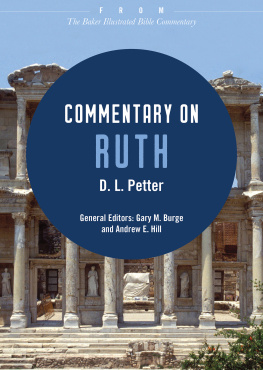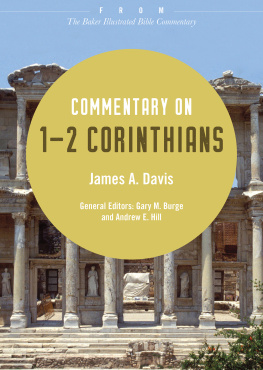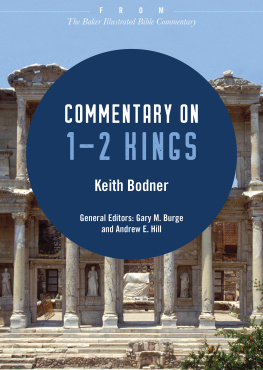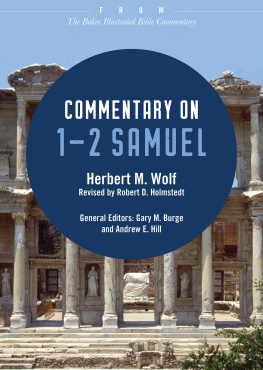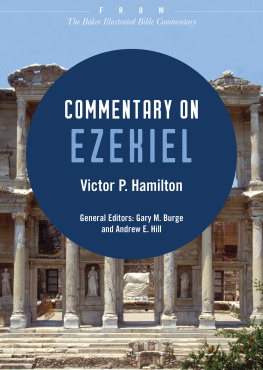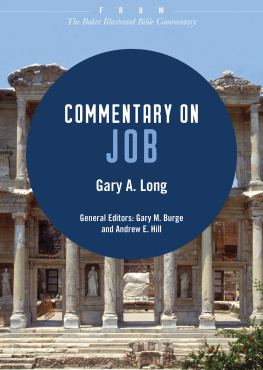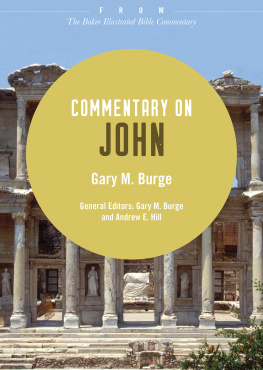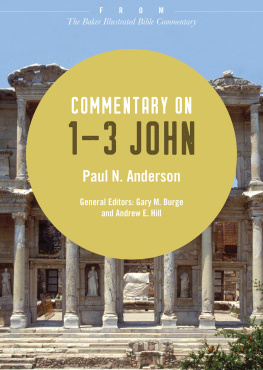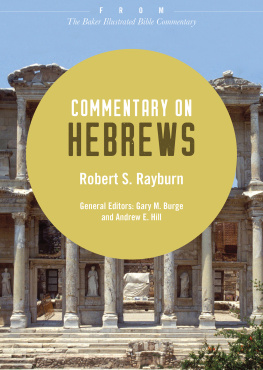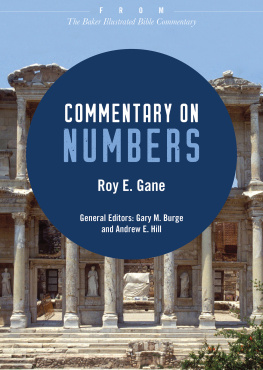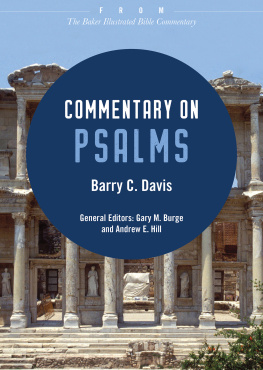D. L. Petter - Commentary on Ruth: From The Baker Illustrated Bible Commentary
Here you can read online D. L. Petter - Commentary on Ruth: From The Baker Illustrated Bible Commentary full text of the book (entire story) in english for free. Download pdf and epub, get meaning, cover and reviews about this ebook. year: 2019, publisher: Baker Publishing Group, genre: Romance novel. Description of the work, (preface) as well as reviews are available. Best literature library LitArk.com created for fans of good reading and offers a wide selection of genres:
Romance novel
Science fiction
Adventure
Detective
Science
History
Home and family
Prose
Art
Politics
Computer
Non-fiction
Religion
Business
Children
Humor
Choose a favorite category and find really read worthwhile books. Enjoy immersion in the world of imagination, feel the emotions of the characters or learn something new for yourself, make an fascinating discovery.
- Book:Commentary on Ruth: From The Baker Illustrated Bible Commentary
- Author:
- Publisher:Baker Publishing Group
- Genre:
- Year:2019
- Rating:5 / 5
- Favourites:Add to favourites
- Your mark:
- 100
- 1
- 2
- 3
- 4
- 5
Commentary on Ruth: From The Baker Illustrated Bible Commentary: summary, description and annotation
We offer to read an annotation, description, summary or preface (depends on what the author of the book "Commentary on Ruth: From The Baker Illustrated Bible Commentary" wrote himself). If you haven't found the necessary information about the book — write in the comments, we will try to find it.
D. L. Petter: author's other books
Who wrote Commentary on Ruth: From The Baker Illustrated Bible Commentary? Find out the surname, the name of the author of the book and a list of all author's works by series.
Commentary on Ruth: From The Baker Illustrated Bible Commentary — read online for free the complete book (whole text) full work
Below is the text of the book, divided by pages. System saving the place of the last page read, allows you to conveniently read the book "Commentary on Ruth: From The Baker Illustrated Bible Commentary" online for free, without having to search again every time where you left off. Put a bookmark, and you can go to the page where you finished reading at any time.
Font size:
Interval:
Bookmark:
2012 by Baker Publishing Group
Published by Baker Books
a division of Baker Publishing Group
P.O. Box 6287, Grand Rapids, MI 49516-6287
www.bakerbooks.com
Ebook short created 2019
Previously published in The Baker Illustrated Bible Commentary edited by Gary M. Burge and Andrew E. Hill in 2012
All rights reserved. No part of this publication may be reproduced, stored in a retrieval system, or transmitted in any form or by any meansfor example, electronic, photocopy, recordingwithout the prior written permission of the publisher. The only exception is brief quotations in printed reviews.
Library of Congress Cataloging-in-Publication Data is on file at the Library of Congress, Washington, DC.
ISBN 978-1-4934-2446-7
Unless otherwise indicated, Scripture quotations are from the Holy Bible, New International Version. NIV. Copyright 1973, 1978, 1984, 2011 by Biblica, Inc. Used by permission of Zondervan. All rights reserved worldwide. www.zondervan.com. The NIV and New International Version are trademarks registered in the United States Patent and Trademark Office by Biblica, Inc.
Scripture quotations labeled ESV from The Holy Bible, English Standard Version (ESV), copyright 2001 by Crossway, a publishing ministry of Good News Publishers. Used by permission. All rights reserved. ESV Text Edition: 2007
Scripture quotations labeled NASB are from the New American Standard Bible, copyright 1960, 1962, 1963, 1968, 1971, 1972, 1973, 1975, 1977, 1995 by The Lockman Foundation. Used by permission. www.lockman.org
Scripture quotations labeled NIV 1984 are from the HOLY BIBLE, NEW INTERNATIONAL VERSION. NIV. Copyright 1973, 1978, 1984 by International Bible Society. Used by permission of Zondervan. All rights reserved.
Scripture quotations labeled NJPS are from the New Jewish Publication Society Version 1985 by The Jewish Publication Society. All rights reserved.
Scripture quotations labeled NKJV are from the New King James Version. Copyright 1982 by Thomas Nelson, Inc. Used by permission. All rights reserved.
Scripture quotations labeled NLT are from the Holy Bible , New Living Translation, copyright 1996, 2004, 2007 by Tyndale House. Used by permission of Tyndale House Publishers, Inc., Carol Stream, Illinois 60188. All rights reserved.
Scripture quotations labeled NRSV are from the New Revised Standard Version of the Bible, copyright 1989, by the Division of Christian Education of the National Council of the Churches of Christ in the United States of America. Used by permission. All rights reserved.
Scripture quotations labeled RSV are from the Revised Standard Version of the Bible, copyright 1952 [2nd edition, 1971] by the Division of Christian Education of the National Council of the Churches of Christ in the United States of America. Used by permission. All rights reserved.
Unless otherwise indicated, photos, illustrations, and maps are copyright Baker Photo Archive.
| ANET | Ancient Near Eastern Texts Relating to the Old Testament . Edited by J. B. Pritchard. 3rd ed. Princeton, 1969 |
| BDAG | Bauer, W., F. W. Danker, W. F. Arndt, and F. W. Gingrich. Greek-English Lexicon of the New Testament and Other Early Christian Literature. 3rd ed. Chicago, 1999 |
| ca. | circa (about, approximately) |
| cf. | compare |
| chap(s). | chapter(s) |
| COS | The Context of Scripture . Edited by W. W. Hallo. 3 vols. Leiden, 1997 |
| e.g. | for example |
| ESV | English Standard Version |
| HALOT | Koehler, L., W. Baumgartner, and J. J. Stamm. The Hebrew and Aramaic Lexicon of the Old Testament. Translated and edited under the supervision of M. E. J. Richardson. 5 vols. Leiden, 19942000 |
| HCSB | Holman Christian Standard Bible |
| i.e. | that is |
| KJV | King James Version |
| NASB | New American Standard Bible |
| NEB | New English Bible |
| NET | New English Translation |
| NIV | New International Version (2011 edition) |
| NIV 1984 | New International Version (1984 edition) |
| NJB | New Jerusalem Bible |
| NJPS | The Tanakh: The Holy Scriptures: The New JPS Translation according to the Traditional Hebrew Text |
| NKJV | New King James Version |
| NLT | New Living Translation |
| NRSV | New Revised Standard Version |
| RSV | Revised Standard Version |
| TDOT | Theological Dictionary of the Old Testament . Edited by G. J. Botterweck and H. Ringgren. Translated by J. T. Willis, G. W. Bromiley, and D. E. Green. 8 vols. Grand Rapids, 1974 |
| TNIV | Todays New International Version |
D. L. Petter
Introduction
Date and Authorship
This heart-wrenching yet refreshing story unfolds in the days when the judges ruled (1:1). This places the account chronologically somewhere between circa 1380 and 1050 BC. The book was likely composed by an unnamed author relying on oral sources at a later period in Israelite history, one that seems to coincide with David and the early monarchy (Ruth 4:7, 17). Historically, the period of the judges represents a setting when religious syncretism provoked military aggression resulting in societal unrest, a cycle that perpetuated itself until the Lord graciously intervened by raising up a judge (Judges 2). As a literary bridge, the notification in 1:1 points the reader back to the last verse in Judges, where it concludes, In those days Israel had no king; everyone did as they saw fit (Judg. 21:25). It also points forward to the closing genealogy in Ruth, mentioning David (4:1822), which anticipates 12 Samuel, when kingship is formally grafted into the covenantal community. In this way Ruth functions as a literary hinge with respect to its placement in the English Bible (an arrangement based upon the Greek Septuagint).

Theological Themes
Ruth recounts the private and domestic affairs of a family of four from Bethlehem, with literary artistry full of suspense and emotion. Even the most casual reader recognizes themes of divine providence, mercy, and provision for the less privileged. An equally notable and repetitive theme concerns the idea of redemption, particularly evident in Boazs crucial role as kinsman-redeemer.
Collectively, these themes, which are communicated through speech rather than narration, unveil the main point driving the narrative. Ruth finds both a physical and spiritual home in Israel. But how can a Moabite secure a home in Israel and even be included in Davids lineage? These are pertinent questions given Deuteronomic law, which forbids Israelite associations with Moabites, a chided enemy. Moreover, how can Israels renowned king come from mixed ancestry? The book of Ruth not only lauds the Lords merciful hand of guidance on Naomi and Ruth but also addresses these intriguing questions in light of the bigger picture of Israelite history.
Commentary
The grim opening of this story grips the reader on three counts. First, it is neither a prosperous nor a fruitful time in the nations life (1:1). Second, and not unrelated, the people of Israel face famine (1:1). The fact that a famine prevails in Bethlehem, in Judahs house of bread, together with the religious crisis dominating the landscape indicates an unpleasant visitation by the Lord on the land. The Lord promised famine as one among many of his acts of judgment for covenantal waywardness (Lev. 26:1820; Deut. 28:24; Jer. 24:10; 27:813; 29:17; 34:17; 38:2; Ezek. 6:11; 7:15; 12:16). The writer now zooms in on one specific family and their attempt to deal with these circumstances. Elimelek, his wife Naomi, and their two sons Mahlon and Kilion relocate from Bethlehem to the neighboring fields of Moab in search of food. Their relocation to Moab suggests that in spite of previous tumultuous relationships between Moab and Israel (Numbers 22; 25), relative peace prevails at the time the family uproots (Judg. 3:11; 5:31). Although the stated motivation of finding food provides a logical rationale for moving, one wonders if it does not point to the fragile nature of Elimeleks faith, much like the faith of Israels patriarchs who went to Egypt in time of famine (Gen. 12:10; 26:1; 41:5457). However one interprets their journey, the family attempts to face their crisis practically by securing necessary food.
Font size:
Interval:
Bookmark:
Similar books «Commentary on Ruth: From The Baker Illustrated Bible Commentary»
Look at similar books to Commentary on Ruth: From The Baker Illustrated Bible Commentary. We have selected literature similar in name and meaning in the hope of providing readers with more options to find new, interesting, not yet read works.
Discussion, reviews of the book Commentary on Ruth: From The Baker Illustrated Bible Commentary and just readers' own opinions. Leave your comments, write what you think about the work, its meaning or the main characters. Specify what exactly you liked and what you didn't like, and why you think so.

